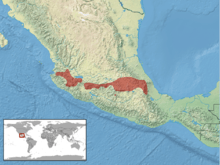Crotalus triseriatus
| Crotalus triseriatus | |
|---|---|
| Scientific classification | |
| Kingdom: | Animalia |
| Phylum: | Chordata |
| Class: | Reptilia |
| Order: | Squamata |
| Suborder: | Serpentes |
| Family: | Viperidae |
| Genus: | Crotalus |
| Species: | C. triseriatus |
| Binomial name | |
| Crotalus triseriatus (Wagler, 1830) | |
 | |
| Synonyms | |
| |
Crotalus triseriatus is a venomous pit viper species found in Mexico. Two subspecies are currently recognized, including the nominate subspecies described here.[4]
Description
Adult male specimens of C. triseriatus commonly grow to a total length (including tail) greater than 60 cm (24 in), with females somewhat smaller. The maximum recorded total length is 68.3 cm (26.9 in).[2]
Geographic range
The species C. triseriatus is found in Mexico, along the southern edge of the Mexican Plateau in the highlands of the Transverse Volcanic Cordillera, including the states of Nayarit, Jalisco, Michoacán, Morelos, México, Puebla, Tlaxcala, and Veracruz. The type locality given by Wagler in 1830 is "Mexico". A restriction to "Alvarez, San Luis Potosí, Mexico" was proposed by H.M. Smith and Taylor (1950).[1]
Habitat
Crotalus triseriatus occurs in pine-oak forest, boreal forest, coniferous forest and, bunchgrass grasslands. On Volcán Orizaba, it is found at very high altitudes. There, the snow line comes down to about 4,572 m (15,000 ft), while green plants can be found up to 4,573 m (15,003 ft): the species has been found within this zone. However, it is most common at 2,700 to 3,350 metres (8,860 to 10,990 ft) in elevation.[2]
Conservation status
The species C. triseriatus is classified as Least Concern on the IUCN Red List of Threatened Species (v3.1, 2001).[5] Species are listed as such due to their wide distribution, presumed large population, or because they are unlikely to be declining fast enough to qualify for listing in a more threatened category. The population trend was stable when assessed in 2007.[6]
Feeding
Prey reportedly found in stomachs of C. triseriatus include a frog, a murid rodent (Neotomodon alstoni), lizards, other small mammals, crickets, and salamanders.[2]
Venom
Bite symptoms from C. triseriatus are reported to include intense pain, swelling, faintness, and cold perspiration.[2]
Subspecies
| Subspecies[4] | Taxon author[4] | Common name[3] | Geographic range[1][2] |
|---|---|---|---|
| C. t. armstrongi | Campbell, 1979 | western dusky rattlesnake | Mexico: Jalisco and Nayarit |
| C. t. triseriatus | (Wagler, 1830) | dusky rattlesnake | Mexico: Michoacán, Morelos, México, Puebla, Tlaxcala and Veracruz |
Etymology
The subspecific name, armstrongi, is in honor of American herpetologist Barry L. Armstrong.[7]
Taxonomy
In the relatively recent past, two additional subspecies were described:[2]
- C. t. anahuacus Gloyd, 1940 - currently regarded as a junior synonym of C. t. triseriatus
- C. t. quadrangularis Harris & Simmons, 1978 - currently regarded as a junior synonym of C. aquilus
See also
- List of crotaline species and subspecies
- Crotalus by common name
- Crotalus by taxonomic synonyms
- Crotalinae by common name
- Crotalinae by taxonomic synonyms
- Snakebite
References
- 1 2 3 McDiarmid RW, Campbell JA, Touré TA (1999). Snake Species of the World: A Taxonomic and Geographic Reference, Volume 1. Washington, District of Columbia: Herpetologists' League. 511 pp. ISBN 1-893777-00-6 (series). ISBN 1-893777-01-4 (volume).
- 1 2 3 4 5 6 7 Campbell JA, Lamar WW (2004). The Venomous Reptiles of the Western Hemisphere. Ithaca and London: Comstock Publishing Associates. 870 pp. 1500 plates. ISBN 0-8014-4141-2.
- 1 2 Mehrtens JM (1987). Living Snakes of the World in Color. New York: Sterling Publishers. 480 pp. ISBN 0-8069-6460-X.
- 1 2 3 "Crotalus triseriatus". Integrated Taxonomic Information System. Retrieved 1 August 2007.
- ↑ Crotalus triseriatus at the IUCN Red List. Accessed 13 September 2007.
- ↑ 2001 Categories & Criteria (version 3.1) at the IUCN Red List. Accessed 13 September 2007.
- ↑ Beolens, Bo; Watkins, Michael; Grayson, Michael (2011). The Eponym Dictionary of Reptiles. Baltimore: Johns Hopkins University Press. xiii + 296 pp. ISBN 978-1-4214-0135-5. (Crotalus triseriatus armstrongi, p. 11).
Further reading
- Wagler J (1830). Natürliches System der AMPHIBIEN, mit vorangehender Classification der SÄUGTHIERE und VÖGEL. Ein Beitrag zur vergleichenden Zoologie. München, Stuttgart and Tübingen: J.G. Cotta. vi + 354 pp. + one plate. (Uropsophus triseriatus, new species, p. 176). (in German and Latin).
External links
- Crotalus triseriatus at the Reptarium.cz Reptile Database. Accessed 12 December 2007.
